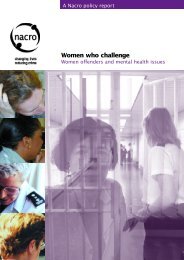Running a resettlement project for young offenders - Nacro
Running a resettlement project for young offenders - Nacro
Running a resettlement project for young offenders - Nacro
You also want an ePaper? Increase the reach of your titles
YUMPU automatically turns print PDFs into web optimized ePapers that Google loves.
Tätigkeitsbericht derJugendwartefür das Jahr 2009
<strong>Running</strong> a <strong>resettlement</strong> <strong>project</strong> <strong>for</strong> <strong>young</strong> <strong>offenders</strong>Conclusionthey could to help the <strong>young</strong> people, includingrelocating <strong>young</strong> people so they were morelikely to stay out of trouble, and referring themto drug support services such as the CARATservice (counselling assessment referral advicethroughcare service), once it was established inthe prison. Such intervention did make animpact: On-Side participants identified withproblematic drug use were more likely to bereconvicted than those without a drug problem,even if they received some help from the<strong>project</strong>. However, those who did not receive anyhelp to overcome their problems were muchmore likely to be reconvicted than those whodid get help. This again highlights theimportance of providing such support <strong>for</strong> the<strong>young</strong> person.‘Yes, it’s helped me a lot really because if it wasn’t<strong>for</strong> this, I would probably be going out and just begoing back to the same old stuff, doing, just beingnothing really.’The national reconviction rate <strong>for</strong> juvenile<strong>offenders</strong> who have been detained is 84%. Thereconviction rate <strong>for</strong> On-Side participants, at58%, shows that the <strong>project</strong> has been a particularsuccess – especially given that the <strong>young</strong> peoplewith whom it has dealt are some of the mostvulnerable in society. 5 Those on the On-Side<strong>project</strong> who received help with employmentand/or education, accommodation, mental healthproblems, and violence and anger managementwere all less likely to be reconvicted than thosewho did not get help with identified problems. Itis imperative, there<strong>for</strong>e, that juvenile <strong>offenders</strong>are released from custody with comprehensive<strong>resettlement</strong> packages involving intensive,individualised support.Given that On-Side has reduced re-offendingrates among prolific <strong>offenders</strong>, it could beclaimed that the <strong>project</strong> has brought aboutsubstantial savings to the criminal justicesystem.Furthermore, On-Side has offered ‘added value’to both HMYOI Portland and numerous statutoryagencies, including social services, youth justiceteams, the Probation Service, and more recently,area youth offending teams. Developing ajoined-up approach, could not only create agreater understanding of the difficulties thatthese <strong>young</strong> people face, but also show that,with the right help, such problems can beovercome.5 Please note that the full two-year reconviction rate is not yetavailable <strong>for</strong> all On-Side participants: at the time of evaluation,data on a two-year follow-up were only available <strong>for</strong> thosewho joined the <strong>project</strong> soon after it started. For theseparticipants, the reconviction rate was 60%. More in<strong>for</strong>mationon these figures is contained in the On-Side evaluation report(<strong>for</strong>thcoming, contact details on p.2).page 9
About <strong>Nacro</strong><strong>Nacro</strong>, the crime reduction charity, is dedicated to makingsociety safer. We have an unrivalled expertise in developingeffective solutions to crime and stimulating fresh thinking onhow best to reduce it, based on over 30 years of experience.Combining practical services to individuals, communities andorganisations with pioneering campaigns, <strong>Nacro</strong> lobbies <strong>for</strong>better ways to reduce crime, while demonstrating how thismight be done in practice.<strong>Nacro</strong>’s <strong>resettlement</strong> service<strong>Nacro</strong>’s <strong>resettlement</strong> service provides in<strong>for</strong>mation and advice<strong>for</strong> prisoners, ex-<strong>offenders</strong> and people involved or working withthem. If you want to find out more about <strong>Nacro</strong>’s <strong>resettlement</strong>service, contact <strong>Nacro</strong>’s Resettlement Plus Helpline, 169Clapham Road, London, SW9 0PU, tel: 020 7840 6464.<strong>Nacro</strong>’s Research and Evaluation Section<strong>Nacro</strong>’s Research and Evaluation Section runs major researchand evaluation contracts across the breadth of crime reductionand criminal justice fields. The section produces a regularnewsletter, Evidence <strong>for</strong> change, and briefings. The briefingsand newsletter are circulated in a regular mailing and posted onthe <strong>Nacro</strong> website, www.nacro.org.ukTo find out about the research mailing, contactinfo@nacrocsp.org.uk or 020 7501 0551. For more in<strong>for</strong>mationabout the work of the Research and Evaluation Section, contactresearchinfo@nacrocsp.org.ukpage 10
<strong>Running</strong> a <strong>resettlement</strong> <strong>project</strong> <strong>for</strong> <strong>young</strong> <strong>offenders</strong>Key findings from <strong>Nacro</strong>’s On-Side <strong>project</strong>Intensive <strong>resettlement</strong> work with the <strong>young</strong> people has been a vital factor inreducing reconvictions and breaking the cycle of crime. <strong>Nacro</strong>’s On-Side <strong>project</strong> atHMYOI Portland was established to ensure that the most vulnerable juveniles inthe prison received the in<strong>for</strong>mation, help and support they need to identify andtackle the range of difficulties they are likely to face on release. This reportdiscusses the strengths of the On-Side <strong>project</strong> in working with juvenile <strong>offenders</strong>and significantly reducing re-offending. It looks at the people involved, theapproaches taken to reduce reoffending, and the benefits that were gained. Itstresses the importance of seeing <strong>young</strong> people as part of the solution to reducingcrime and disorder, not just as part of the problem.£5.00

















